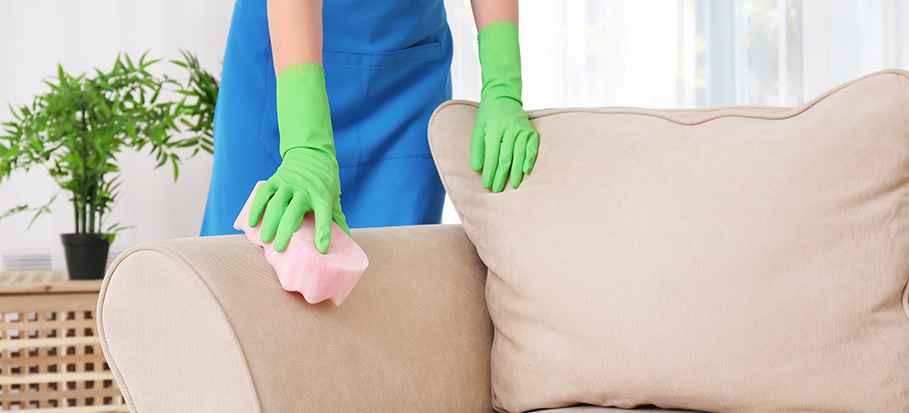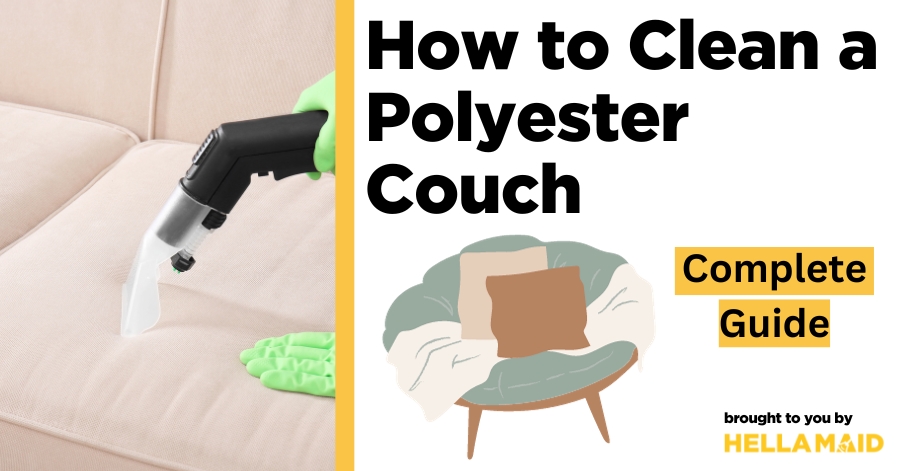To clean a polyester couch, start by vacuuming the surface to remove debris and dirt. Then, use a mixture of mild detergent and water to spot clean any stains.
A polyester couch is a stylish and comfortable addition to any living space. However, over time, it can accumulate dirt, stains, and odors. To keep your polyester couch looking its best, regular cleaning is essential. In this blog post, we will discuss the best methods for cleaning a polyester couch, including how to remove stains, eliminate odors, and maintain the overall appearance of the fabric.
By following these simple tips, you can ensure that your polyester couch remains in top condition for years to come.
Introduction To Polyester Couch Care
Maintaining the cleanliness of your polyester couch is essential for its longevity. Regular vacuuming and spot cleaning with a mild detergent solution can effectively remove dirt and stains. For deeper cleaning, consider using a steam cleaner or seeking professional upholstery cleaning services to ensure your polyester couch stays in top condition.
Benefits Of Choosing Polyester
Importance Of Regular Cleaning

Credit: www.tiktok.com
Identifying Your Couch’s Fabric
Before you start cleaning your polyester couch, it is essential to identify the fabric of your couch. Knowing the type of fabric will help you choose the right cleaning solution and method to clean your couch effectively. In this section, we will discuss how to identify your couch’s fabric.
Reading The Manufacturer’s Label
The easiest way to identify your couch’s fabric is to check the manufacturer’s label. The label is usually located under the couch cushions or on the underside of the couch. The label provides valuable information on the type of fabric, cleaning instructions, and care recommendations.
The label may use acronyms or symbols to indicate the type of fabric. Here are some common abbreviations:
| Abbreviation | Meaning |
|---|---|
| P | Polyester |
| S | Synthetic |
| W | Water-based cleaner |
| S/W | Water-based or solvent-based cleaner |
| X | Vacuum only |
If the label states that the fabric is “X,” it means that the couch should only be cleaned with a vacuum. If the label states “S/W” or “W,” it means that you can use a water-based or solvent-based cleaner.
Types Of Polyester Fabrics
There are various types of polyester fabrics, and each type requires different cleaning methods. Here are some common polyester fabrics:
- Microfiber: It is a synthetic fabric that is soft and durable. It is water-resistant, stain-resistant, and easy to clean.
- Velvet: It is a soft and luxurious fabric with a thick pile. It is prone to crushing and fading and requires gentle cleaning.
- Chenille: It is a plush fabric that has a raised texture. It is prone to snagging and requires special care when cleaning.
- Outdoor polyester: It is a durable and weather-resistant fabric that is used for outdoor furniture. It requires regular cleaning to prevent mold and mildew growth.
Once you have identified the type of polyester fabric, you can choose the appropriate cleaning method to clean your couch effectively.
Pre-cleaning Preparations
Before diving into the process of cleaning your polyester couch, it’s crucial to prepare the space and gather the necessary supplies. These pre-cleaning preparations will ensure that you have everything you need on hand and create a conducive environment for the cleaning process.
Gathering Necessary Supplies
Ensure you have the following supplies ready before you begin cleaning your polyester couch:
- Soft-bristled brush or vacuum cleaner
- Mild detergent or upholstery cleaner
- White microfiber cloths or sponges
- Bucket of lukewarm water
- Soft, clean towels
- Optional: Upholstery protector spray
Removing Loose Objects And Cushions
Start by removing any loose objects such as pillows, throws, and cushions from the couch. This will allow you to thoroughly clean all surfaces and ensure that no areas are overlooked during the cleaning process.

Credit: blog.fantasticservices.com
Vacuuming Your Polyester Couch
Vacuuming your polyester couch is an essential step in maintaining its cleanliness and prolonging its lifespan. Regular vacuuming helps to remove dirt, dust, and debris that can accumulate on the surface and in the crevices of the couch. By using the right attachments and implementing effective dust removal techniques, you can keep your polyester couch looking fresh and inviting.
Using The Right Attachments
When vacuuming your polyester couch, it’s crucial to use the right attachments to ensure thorough cleaning. Opt for a soft brush attachment or an upholstery tool with gentle bristles to prevent any damage to the fabric. These attachments are designed to effectively lift and remove dirt and dust without causing abrasion or pilling.
Techniques For Effective Dust Removal
Implementing the right techniques for dust removal is key to achieving a clean polyester couch. Begin by using the upholstery tool or soft brush attachment to gently vacuum the entire surface of the couch. Work in a systematic manner, paying attention to areas where dust tends to accumulate, such as the seams and crevices. Ensure that you cover all the nooks and crannies to eliminate as much dust as possible.
Spot Cleaning Stains
Spot cleaning stains on your polyester couch can be a simple and effective way to maintain its appearance and extend its lifespan. By using the right cleaning solutions and techniques, you can tackle stains and spills without damaging the fabric.
Safe Cleaning Solutions For Polyester
When dealing with stains on your polyester couch, it’s crucial to use safe cleaning solutions that won’t cause discoloration or damage to the fabric. Mild dish soap mixed with water is a gentle yet effective option for treating most stains. For tougher stains, a mixture of white vinegar and water can be used, as it helps to break down grease and grime without harming the polyester fibers.
Blotting Vs. Scrubbing
When it comes to removing stains from your polyester couch, it’s important to avoid aggressive scrubbing, as this can push the stain deeper into the fabric. Instead, opt for gentle blotting with a clean, dry cloth to lift the stain from the surface. This method helps to prevent spreading the stain and causing further damage to the fabric.

Credit: hellamaid.ca
Deep Cleaning Methods
Cleaning your polyester couch regularly helps to maintain its appearance and prolong its lifespan. However, sometimes a deeper clean is necessary to remove stubborn stains and odors. Here are some effective deep cleaning methods to keep your polyester couch looking fresh and clean.
Using A Steam Cleaner
Using a steam cleaner is an efficient way to deep clean your polyester couch. Start by vacuuming the couch to remove any loose dirt and debris. Then, fill the steam cleaner with water and an appropriate cleaning solution. Use the steam cleaner to apply the solution to the couch, working in small sections. Allow the couch to dry thoroughly before using it again.
Applying A Fabric Cleaner
Applying a fabric cleaner specifically designed for polyester upholstery can also help deep clean your couch. Before applying the cleaner, test it on a small, inconspicuous area of the couch to ensure it does not cause any damage. Once confirmed, apply the cleaner to the stained or soiled areas according to the manufacturer’s instructions. Use a clean cloth to blot the treated areas and remove any excess moisture.
Drying And Airing Out
To clean a polyester couch, start by vacuuming to remove debris. Then, use a mixture of mild detergent and water to spot clean any stains. Gently scrub the area with a soft-bristled brush and then wipe it with a clean, damp cloth.
Finally, let it air dry completely before using the couch again.
After cleaning your polyester couch, it is crucial to dry and air it out properly to prevent any moisture-related damage. Here are some best practices for drying your polyester couch and airing it out to ensure it remains in good condition.Best Practices For Drying
Once you have finished cleaning your polyester couch, use a clean towel to absorb any excess moisture. Then, leave the couch to air dry naturally, but be sure to avoid direct sunlight and heat sources such as radiators, as they can cause shrinkage and damage to the fabric. If you need to speed up the drying process, use a fan or dehumidifier to circulate air around the couch. Ensure that the fan or dehumidifier is not too close to the couch, as this can cause damage.Ventilation Tips
Proper ventilation is essential when drying and airing out your polyester couch. Open windows and doors to encourage air circulation and allow moisture to escape. This will also help to prevent any unpleasant smells from building up. If you live in a humid environment, consider using a dehumidifier to remove excess moisture from the air. This will help to prevent mold and mildew growth on your couch. By following these best practices for drying and airing out your polyester couch, you can keep it looking and feeling like new for years to come. Remember to avoid direct sunlight and heat sources, use a fan or dehumidifier if needed, and ensure proper ventilation to prevent moisture build-up.Maintaining A Clean Couch
Regular Maintenance Schedule
Set a routine to vacuum your polyester couch weekly to remove dust and debris.
Use a soft brush attachment to prevent damaging the fabric.
Spot clean any spills immediately with a damp cloth and mild detergent.
Preventive Measures
Place a washable cover on your couch to protect it from stains and spills.
Rotate and flip cushions regularly to ensure even wear and tear.
Avoid direct sunlight exposure to prevent fading and damage to the fabric.
Addressing Common Issues
Polyester couches are a popular choice for many households due to their durability and ease of maintenance. However, they can still face common issues like persistent odors and pet hair accumulation. Here’s how to tackle these problems effectively:
Dealing With Persistent Odors
If your polyester couch has lingering odors, start by sprinkling baking soda over the surface and letting it sit for a few hours. Vacuum the couch thoroughly to remove the baking soda along with the odors.
Managing Pet Hair And Dander
- Regularly vacuum your polyester couch to remove pet hair and dander.
- Use a lint roller or a damp cloth to pick up stubborn pet hair from the fabric.
- Consider using a pet-specific vacuum attachment for more effective hair removal.
Final Touches And Refreshing Your Couch
Fluffing Pillows And Cushions
Give your pillows and cushions a good shake to fluff them up.
Adding Protective Covers
Invest in protective covers to shield your polyester couch from stains and spills.
Frequently Asked Questions
How Do You Clean A Polyester Couch At Home?
To clean a polyester couch at home, vacuum first. Mix mild soap with warm water. Dampen a cloth, blot stains gently. Rinse with clean water and dry with a towel.
Is A 100% Polyester Couch Easy To Clean?
Yes, a 100% polyester couch is easy to clean. Use mild soap and water for regular cleaning.
What Is The Best Cleaner For Polyester Fabric?
The best cleaner for polyester fabric is mild detergent mixed with water. Gently scrub the stained area and let it air dry.
Can You Steam Clean A Polyester Couch?
Yes, you can steam clean a polyester couch, but you should be careful. Make sure to use a low-heat setting and test a small, inconspicuous area first. Be sure to follow the manufacturer’s instructions and avoid getting the couch too wet.
Allow the couch to dry completely before using it again.
Conclusion
Keeping your polyester couch clean is simple. Regular vacuuming and gentle cleaning can maintain its beauty. Avoid harsh chemicals to prevent damage. By following these tips, you can enjoy a fresh and inviting living space. Show your couch some care and it will last longer.
